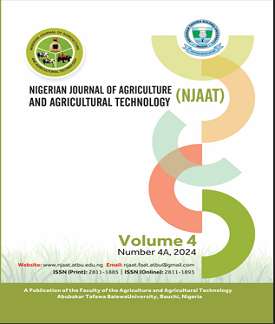PHYSICOCHEMICAL PROPERTIES OF RAW AND FERMENTED COW MILK PRODUCED BY SMALLHOLDER FARMERS IN BAUCHI METROPOLIS, NIGERIA
DOI:
https://doi.org/10.59331/njaat.v4i4A.859Keywords:
Physicochemical properties, raw cow milk, fermented milk, smallholder farmersAbstract
The study was carried out to assess the physicochemical properties of raw and fermented cow milk produced by smallholder farmers in Bauchi Metropolis, Nigeria. The key indicators of milk quality used consisted of moisture, fat, protein, lactose, and ash content. Milk samples from five different locations (Lushi, Bayara, Tabuli, Yayire, and Dandango) were analyzed for both raw and fermented states. Raw milk samples exhibited variability in moisture content, with Dandango recording the highest value (80.50%) and Bayara the lowest (73.78%). Solid non-fat content and titratable acidity remained stable across locations, while fat and protein content showed non-significant difference. These variations reflect the impact of environmental factors, feed quality, and milking practices on milk composition. Fermented milk samples revealed a significant differences in moisture and solid non-fat (SNF) content among locations. Yayire recorded the highest moisture content (83.08%), while Bayara had the highest SNF (8.18%), indicating a better nutrient retention in fermentation. The titratable acidity remained consistent, highlighting similar fermentation processes across the study sites. Fat content in fermented milk was generally lower compared to raw milk, with Lushi exhibiting a slightly higher fat concentration. Protein and lactose content did not differ significantly, with Lushi showing the highest protein content (9.25%), likely due to better preservation during fermentation. The study highlights the role of local environmental conditions, traditional milk processing methods, and feeding practices in shaping the physicochemical properties of milk. The results emphasizes the importance of improving milk production and processing techniques among smallholder farmers to ensure better quality and safety. This can lead to enhanced nutritional value and extended shelf life, contributing to public health and economic development in the dairy sector.
Downloads
Downloads
Published
How to Cite
Issue
Section
License
Copyright (c) 2024 Nigerian Journal of Agriculture and Agricultural Technology

This work is licensed under a Creative Commons Attribution-NonCommercial-ShareAlike 4.0 International License.
This work is licensed under a CC Attribution-NonCommercial-ShareAlike 4.0







